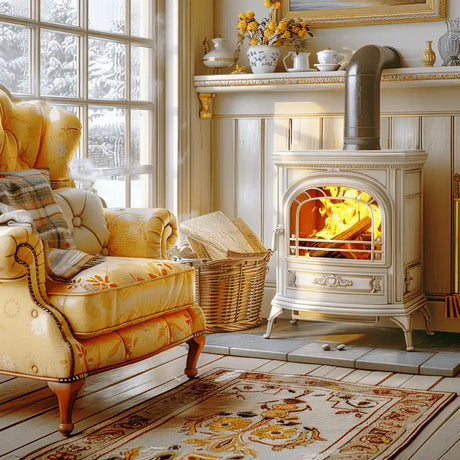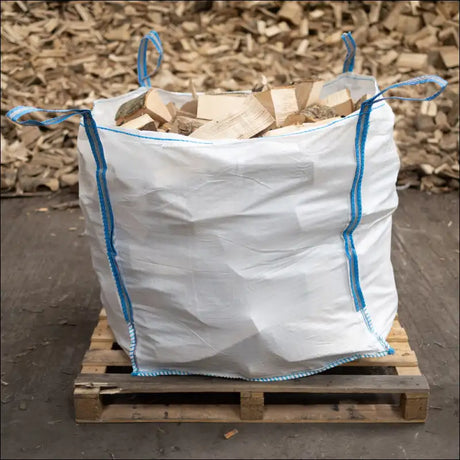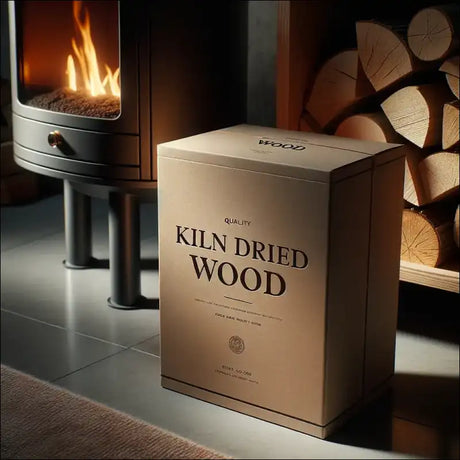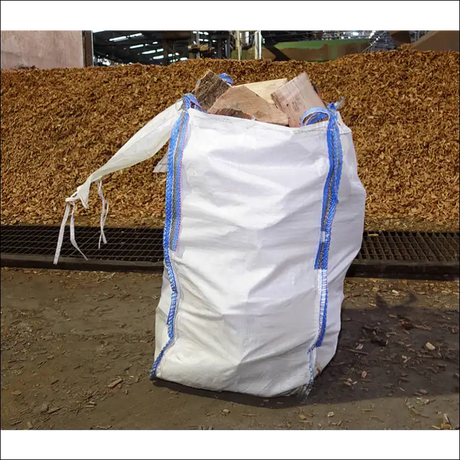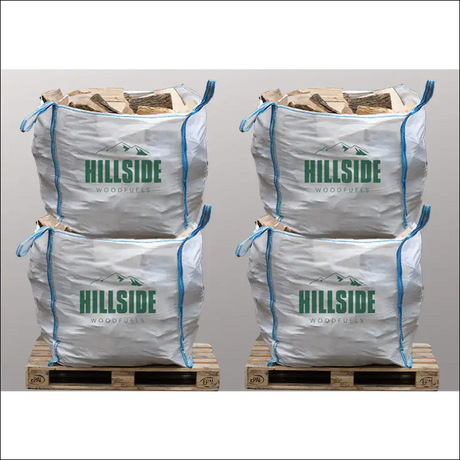Ah, winter in the UK. Those crisp, chilly mornings and long, dark nights beckon us to the warmth and comfort of a roaring fire. But how much firewood do you actually need to keep that hearth glowing all season long? Whether you're a casual burner or someone who relies heavily on wood to warm your living space, we've broken down the key factors to consider when stocking up.
Introduction
As the days get shorter and the temperatures begin to plummet, our thoughts naturally turn to the warmth and ambience that only a real wood fire can provide. Ensuring you have the right amount of firewood in stock is crucial not only for those comforting evenings by the fireplace but also to ensure you're prepared for any unexpected cold snaps. Moreover, there's an undeniable satisfaction in being well-prepared and knowing you have enough wood to last the entire winter. So, how do you strike the right balance between having enough but not overstocking? Let's delve into the first key factor: frequency of use.
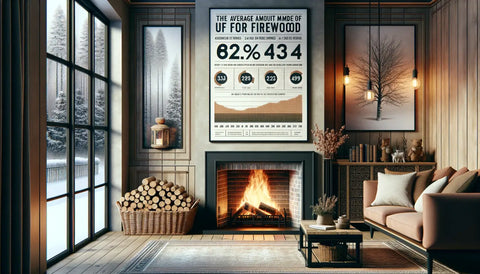
Frequency of Use
Casual use: If you're someone who enjoys the gentle crackle of logs burning primarily during evenings and weekends, your needs are going to be considerably different from someone who keeps their fireplace ablaze day in and day out. For the occasional user, you can expect:
- Evenings and weekends: A cosy fire during these times will see you through with roughly 2 cubic meters of loose logs for the entire season. It might seem like a lot at first glance, but consider this: the average log pile size for a typical evening might consume around 0.02 to 0.03 cubic meters. With winter lasting roughly four months and accounting for those particularly chilly weekends, the maths starts to make perfect sense.
Intensive use: Now, if your wood burner or fireplace is your primary or significant source of heat, and you find yourself frequently stoking the fire:
- All day usage: Those who use their fireplaces or burners intensively will find themselves needing between 3-4 cubic meters of loose logs per season. This might sound daunting, but remember, the fire will be burning continuously, necessitating a constant supply of logs to maintain.
Quick tip: To save on costs and to ensure you have a consistent supply, consider buying in bulk or joining a local firewood co-operative. Many suppliers offer discounts for larger orders, and you might even get free delivery!
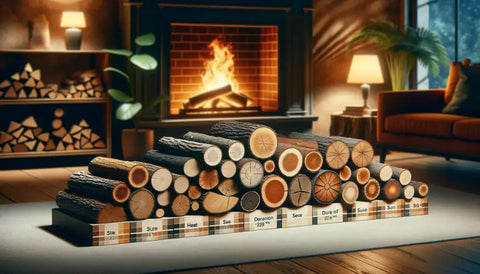
Type of Wood
When considering how much firewood to purchase, the type of wood is an aspect that cannot be ignored. Not all logs are created equal. Some woods burn hotter and longer than others, which can make a significant difference in how much you need. Here's what you should know:
- Kiln-dried hardwood: Renowned for its high heat output and longer burning time, hardwood is a top choice for many. One cubic meter of kiln-dried hardwood, such as oak or ash, can produce significantly more heat than its softwood counterparts. If you've not yet experienced the benefits of kiln dried firewood, now might be the time to give it a go. Not only does it have a lower moisture content (making it easier to light and better for your chimney), but it also ensures a more efficient burn.
- Seasoned softwood: While softwoods like pine or spruce might be more readily available and at times cheaper, they tend to produce less heat and burn more quickly. That means you might find yourself going through your stockpile faster than if you had opted for hardwood. It's not necessarily a bad choice, especially if you're looking for a quick, bright burn, but for sustained heat, hardwood takes the lead.
| Wood Type | Heat Output | Burn Duration |
|---|---|---|
| Kiln-dried hardwood | High | Long |
| Seasoned softwood | Medium to Low | Shorter |
Note: Regardless of the type of wood, always ensure it's well-seasoned or kiln-dried. Wet or 'green' wood can be challenging to light, produces less heat, and can lead to a buildup of creosote in your chimney, which is a fire hazard.
With the foundation laid on the frequency of use and the type of wood, we're well on our way to understanding our firewood needs for the winter. As we'll discover in the coming sections, factors like the efficiency of your wood burner, the size of the area you're heating, and even the unpredictability of UK weather, play a role. But for now, armed with this knowledge, you're one step closer to ensuring a warm and toasty winter.
Efficiency of the Burner or Fireplace
The design and efficiency of your heating source can have a dramatic impact on the amount of firewood you consume. Let's face it, not all fireplaces and wood burners are made equal, and while they all provide that coveted warmth and ambiance, some are just better at squeezing out every last BTU from the logs.
Open Fireplaces
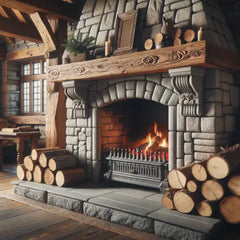
A classic open fireplace is the epitome of winter comfort for many. The sight, sound, and smell of wood crackling in an open hearth evoke feelings of nostalgia and cosiness. However, as romantic and beautiful as they are, open fireplaces are notorious for their inefficiency. With most of the heat escaping through the chimney and a considerable amount of airflow, these fireplaces might consume up to three times the amount of wood compared to a wood burner for the same level of warmth.
Wood Burners
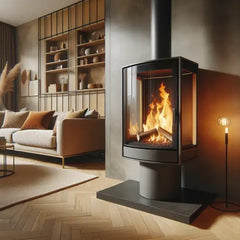
Enter the wood burner, the modern-day superhero of efficient heating. Wood burners, or wood-burning stoves, are designed to maximise heat output and retention. Enclosed by cast iron or steel, they radiate heat into the room while ensuring minimal heat loss. As a result, you burn far less wood while enjoying a consistently warm environment.
| Heating Source | Efficiency | Wood Consumption |
|---|---|---|
| Open Fireplace | Low (20-30% efficiency) | High |
| Wood Burner | High (60-80% efficiency) | Moderate to Low |
Recommendation: If you're still relying on an open fireplace, it might be time to consider investing in a modern wood burner. The initial cost can be offset by the savings in firewood over the years, not to mention the benefits of a cleaner and more eco-friendly burn.
Size of the Area Being Heated
The size of the space you're looking to warm is a key factor when determining your firewood needs. A spacious open-plan living area with high ceilings will understandably demand more logs than a cozy cottage snug.
Here's a more in-depth guide to estimating your firewood needs based on room size:
Small to Medium Rooms (up to 35 sq m)
For smaller spaces like bedrooms, studies, or compact living areas, your firewood needs will be lower, especially if the room has decent insulation.
As a guideline for well-insulated rooms of this size:
- With an open fireplace, estimate 1-2 cubic meters per month for frequent use in winter.
- With an efficient wood burner, 0.5-1 cubic meter per month should suffice.
To put this into perspective, here's a breakdown of anticipated wood consumption for some typical small room sizes:
| Room Size | Fireplace Needs | Stove Needs |
|---|---|---|
| 20 sq m | 1 cubic meter/month | 0.5 cubic meter/month |
| 25 sq m | 1.5 cubic meter/month | 0.75 cubic meter/month |
| 30 sq m | 1.5-2 cubic meter/month | 1 cubic meter/month |
As you can see, upgrading to a modern wood burner can significantly reduce the timber required in a small space.
Medium to Large Rooms (35 - 50 sq m)
For a standard medium living room, dining room, or master bedroom, your firewood requirements will be higher.
Expect to use:
- 2-3 cubic meters per month with an open fire
- 1-2 cubic meters per month with an efficient wood burner
Here's a more detailed breakdown for some typical room sizes in this range:
| Room Size | Fireplace Needs | Stove Needs |
|---|---|---|
| 35 sq m | 2-3 cubic meter/month | 1-1.5 cubic meter/month |
| 40 sq m | 2.5-3 cubic meter/month | 1.5-2 cubic meter/month |
| 45 sq m | 3-4 cubic meter/month | 2-2.5 cubic meter/month |
Large Open Plan Spaces (50+ sq m)
For a spacious open concept living area, kitchen/dining combination, or open lounge, your firewood consumption will be on the higher end to adequately heat the large space.
For frequent winter use, expect:
- 4-6+ cubic meters per month with an open brick fireplace
- 2-4 cubic meters per month with an efficient wood burning stove
Here's a table with estimates for some typical large open plan room sizes:
| Room Size | Fireplace Needs | Stove Needs |
|---|---|---|
| 50 sq m | 4-5 cubic meter/month | 2-3 cubic meter/month |
| 60 sq m | 5-6 cubic meter/month | 3-4 cubic meter/month |
| 70 sq m | 6-7 cubic meter/month | 3-4 cubic meter/month |
| 80 sq m | 6-8 cubic meter/month | 4-5 cubic meter/month |
As shown, the size of the space makes a big impact on your total firewood requirements. Upgrade to an efficient wood stove to reap significant savings.
Whole Home Heating
For those relying entirely on firewood to heat their whole home, especially in older drafty properties, the firewood totals can become quite high during the winter season.
As a general guideline for frequent use:
- 100 sq m home - 4-6 cubic meters per month
- 150 sq m home - 6-9 cubic meters per month
- 200 sq m home - 8-12 cubic meters per month
The table below provides a detailed monthly estimate for heating a range of full home sizes:
| Home Size | Oct | Nov | Dec | Jan | Feb | Mar | Total |
|---|---|---|---|---|---|---|---|
| 100 sq m | 2 | 4 | 6 | 6 | 4 | 2 | 24 cubic meters |
| 150 sq m | 3 | 6 | 9 | 9 | 6 | 3 | 36 cubic meters |
| 200 sq m | 4 | 8 | 12 | 12 | 8 | 4 | 48 cubic meters |
| 250 sq m | 5 | 10 | 15 | 15 | 10 | 5 | 60 cubic meters |
Monitor your actual usage the first year and adjust future purchases accordingly. Combining firewood with a secondary heat source can help lower timber needs.
So in summary, the larger the space being heated, the more firewood you'll require for winter. Use these room size estimates as a starting point when planning your firewood purchases.
Insulation Matters: The quality of your home's insulation can dramatically influence your firewood consumption. Proper insulation will retain heat better, reducing the need for constant burning. If you find yourself burning through logs quickly, it might be worth checking if your home is losing heat through draughts, poorly sealed windows, or inadequate insulation.
Seasonal Weather Conditions
The quintessential British weather! As unpredictable as it is a favourite topic of discussion, the severity of the winter season plays a vital role in determining your firewood needs.

Mild Winters
Not every UK winter is biting cold. Some years, the mercury refuses to drop too low, and the occasional frost is as chilly as it gets. In such conditions, you might find yourself using the fireplace more for ambiance than heat. Your wood consumption in these conditions would likely be on the lower end of the estimates provided.
Harsh Winters
Then there are those winters that seem to bite and gnaw at every exposed bit. Snow, frost, and chilling winds become the daily norm. In such conditions, one firewood forum user even noted burning about 1.5 cubic meters of wood per week!
Weather Apps & Forecasts
While the UK weather is notoriously fickle, modern meteorological predictions are relatively accurate. Keeping an eye on long-term winter forecasts can give you a decent idea of the season's severity. If a colder-than-average winter is predicted, it might be wise to stock up a little more than usual.
Determining your firewood needs is a blend of art and science. While the factors we've discussed provide a solid framework, every home and individual's needs can differ. What's important is to be prepared, ensuring you have enough wood to last the season, keeping you and your loved ones warm and cosy. Remember, it's always better to have a bit extra than to run out on a cold winter night. Stay toasty!


